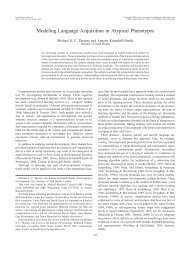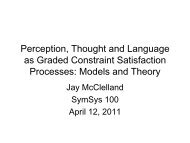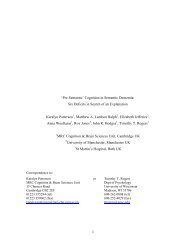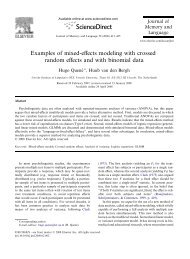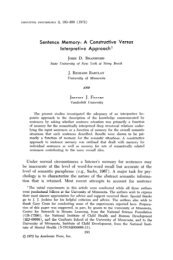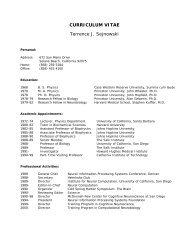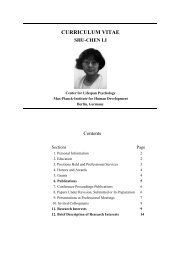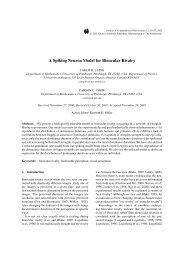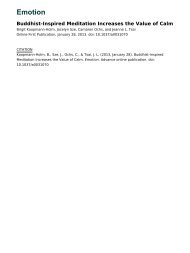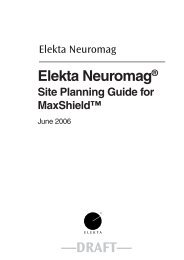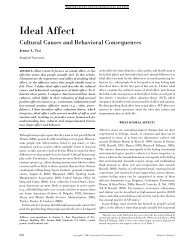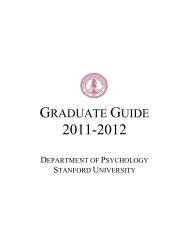Steven Pinker and Michael T. Ullman - Psychology
Steven Pinker and Michael T. Ullman - Psychology
Steven Pinker and Michael T. Ullman - Psychology
You also want an ePaper? Increase the reach of your titles
YUMPU automatically turns print PDFs into web optimized ePapers that Google loves.
<strong>Steven</strong> <strong>Pinker</strong> <strong>and</strong> <strong>Michael</strong> T. <strong>Ullman</strong><strong>Steven</strong> <strong>Pinker</strong>*Dept of Brain <strong>and</strong> Cognitive Sciences, NE20-413, Massachusetts Institute ofTechnology, Cambridge, MA 02139, USA.*e-mail: steve@psyche.mit.edu<strong>Michael</strong> <strong>Ullman</strong>Dept of Neuroscience, Research Building EP-04, Georgetown University, 3900Reservoir Rd, NW, Washington DC 20007, USA.What is the interaction between storage <strong>and</strong> computationin language processing? What is the psychological statusof grammatical rules? What are the relative strengths ofconnectionist <strong>and</strong> symbolic models of cognition? How arethe components of language implemented in the brain?The English past tense has served as an arena for debateson these issues. We defend the theory that irregular pasttenseforms are stored in the lexicon, a division ofdeclarative memory, whereas regular forms can becomputed by a concatenation rule, which requires theprocedural system. Irregulars have the psychological,linguistic <strong>and</strong> neuropsychological signatures of lexicalmemory, whereas regulars often have the signatures ofgrammatical processing. Furthermore, because regularinflection is rule-driven, speakers can apply it whenevermemory fails.For fifteen years, the English past tense has been thesubject of a debate on the nature of language processing.The debate began with the report of a connectionistmodel by Rumelhart <strong>and</strong> McClell<strong>and</strong> [1] <strong>and</strong> a critique by<strong>Pinker</strong> <strong>and</strong> Prince [2], <strong>and</strong> has since been the subject ofmany papers, conferences <strong>and</strong> simulation models [3–7](see also McClell<strong>and</strong> <strong>and</strong> Patterson in this issue [8]).The past tense is of theoretical interest because itembraces two strikingly different phenomena. Regularinflection, as in walk-walked <strong>and</strong> play-played, appliespredictably to thous<strong>and</strong>s of verbs <strong>and</strong> is productivelygeneralized to neologisms such as spam-spammed <strong>and</strong>mosh-moshed, even by preschool children [9]. Irregularinflection, as in come-came <strong>and</strong> feel-felt, applies inunpredictable ways to some 180 verbs, <strong>and</strong> is seldomgeneralized; rather, the regular suffix is oftenovergeneralized by children to these irregular forms, asin holded <strong>and</strong> breaked [10,11]. A simple explanation isthat irregular forms must be stored in memory, whereasregular forms can be generated by a rule that suffixes -edto the stem [12,13]. Rumelhart <strong>and</strong> McClell<strong>and</strong>challenged that explanation with a pattern-associatormodel (RMM) that learned to associate phonologicalfeatures of the stem with phonological features of thepast-tense form. It thereby acquired several hundredregular <strong>and</strong> irregular forms <strong>and</strong> overgeneralized –ed tosome of the irregulars.The past tense has served as one of the main empiricalphenomena used to contrast the strengths <strong>and</strong>weaknesses of connectionist <strong>and</strong> rule-based models oflanguage <strong>and</strong> cognition [8]. More generally, becauseinflections like the past tense are simple, frequent, <strong>and</strong>prevalent across languages, <strong>and</strong> because the regular <strong>and</strong>irregular variants can be equated for complexity <strong>and</strong>meaning, they have served as a test case for issues suchas the neurocognitive reality of rules <strong>and</strong> other symbolmanipulatingoperations <strong>and</strong> the interaction betweenstorage <strong>and</strong> computation in cognitive processing [5–7].In this article we defend the side of this debate thatmaintains that rules are indispensable for explaining thepast tense, <strong>and</strong> by extension, language <strong>and</strong> cognitiveprocesses [3–5,14]. We review what the theory does <strong>and</strong>doesn’t claim, the relevant evidence, the connectionistchallenges, <strong>and</strong> our hopes for the future of the debate.The Words-<strong>and</strong>-Rules theoryThe Words <strong>and</strong> Rules (WR) theory claims that theregular–irregular distinction is an epiphenomenon of thedesign of the human language faculty, in particular, thedistinction between lexicon <strong>and</strong> grammar made in mosttraditional theories of language. The lexicon is asubdivision of memory containing (among other things)the thous<strong>and</strong>s of arbitrary sound–meaning pairingsunderlying the morphemes <strong>and</strong> simple words of alanguage. The grammar is a system of productive,combinatorial operations that assemble morphemes <strong>and</strong>simple words into complex words, phrases <strong>and</strong> sentences.Irregular forms are just words, acquired <strong>and</strong> stored likeother words, but with a grammatical feature like ‘pasttense’ incorporated into their lexical entries. Regularforms, by contrast, can be productively generated by arule, just like phrases <strong>and</strong> sentences. A stored inflectedform of a verb blocks the application of the rule to thatverb (e.g. brought pre-empts bringed). Elsewhere (bydefault) the rule applies: it concatenates –ed with thesymbol 'V', <strong>and</strong> thus can inflect any word categorized as averb (see Fig. 1).Irregular forms, then, do not require an ‘exceptionmodule’. They arise because the two subsystems overlapin their expressive power: a given combination of featurescan be expressed by words or rules. Thus either a word(irregular) or a rule-product (regular) can satisfy thedem<strong>and</strong> of a syntactic or semantic representation that afeature such as past tense be overtly expressed.Diachronically, an irregular is born when (for variousreasons) learners memorize a complex word outright,rather than parsing it into a stem <strong>and</strong> an affix that codesthe feature autonomously [3].The WR theory contrasts with classical theories ofgenerative phonology <strong>and</strong> their descendents, such asthose of Chomsky <strong>and</strong> Halle [15–17], which generateirregular forms by affixing an abstract morpheme to the1
stem <strong>and</strong> applying rules that alter the stem’sphonological composition. Such theories are designed toaccount for the fact that most irregular forms are notcompletely arbitrary but fall into families displayingpatterns, as in ring-rang, sink-sank, sit-sat, <strong>and</strong> feel-felt,sleep-slept, bleed-bled. A problem for this view is thatirregular families admit numerous positive <strong>and</strong> negativecounterexamples <strong>and</strong> borderline cases, so any set of ruleswill be complex <strong>and</strong> laden with exceptions, unless itposits implausibly abstract underlying representations(e.g. rin for run, which allows the verb to undergo thesame rules as sing-sang-sung).The theory also contrasts with the Rumelhart–McClell<strong>and</strong> model (RMM) <strong>and</strong> other connectionist modelsthat posit a single pattern associator, with neither lexicalentries nor a combinatorial apparatus [1,18,19]. The keyto these pattern associators is that rather than linking aword to a word stored in memory, they link sounds tosounds. Because similar words share sounds, theirrepresentations are partly superimposed, <strong>and</strong> anyassociation formed to one is automatically generalized tothe others. This allows such models to acquire families ofsimilar forms more easily than arbitrary sets, <strong>and</strong> togeneralize the patterns to new similar words. Havingbeen trained on fling-flung <strong>and</strong> cling-clung, they maygeneralize to spling-splung (as children <strong>and</strong> adultsoccasionally do [19,20]); <strong>and</strong> having been trained on flipflipped<strong>and</strong> clip-clipped, they generalize to plip-plipped.WR is descended from a third approach: the lexicalisttheories of Jackendoff, Lieber, <strong>and</strong> others, who recognizedthat many morphological phenomena are neitherarbitrary lists nor fully systematic <strong>and</strong> productive [22–25]. They posited ‘lexical redundancy rules’, which do notfreely generate new forms but merely capture patterns ofredundancy in the lexicon, <strong>and</strong> allow sporadicgeneralization by analogy. <strong>Pinker</strong> <strong>and</strong> Prince proposedthat lexical redundancy rules are not rules at all, butconsequences of the superpositional nature of memory:similar items are easier to learn than arbitrary sets, <strong>and</strong>new items resembling old ones tend to inherit theirproperties. They argued that RMM’s successes came fromimplementing this feature of memory, <strong>and</strong> proposed theWR theory as a lexicalist compromise between thegenerative <strong>and</strong> connectionist extremes. Irregulars arestored in a lexicon with the superpositional property ofpattern associators; regulars can be generated or parsedby rules.<strong>Ullman</strong> <strong>and</strong> colleagues have recently extended the WRtheory to a hypothesis about the neurocognitive substrateof lexicon <strong>and</strong> grammar. According to theDeclarative/Procedural (DP) hypothesis [5,26], lexicalmemory is a subdivision of declarative memory, whichstores facts, events <strong>and</strong> arbitrary relations [27,28]. Theconsolidation of new declarative memories requiresmedial-temporal lobe structures, in particular thehippocampus. Long-term retention depends largely onneocortex, especially temporal <strong>and</strong> parietal regions; otherstructures are important for actively retrieving <strong>and</strong>searching for these memories. Grammatical processing,by contrast, depends on the procedural system, whichunderlies the learning <strong>and</strong> control of motor <strong>and</strong> cognitiveskills, particularly those involving sequences [27,28]. It issubserved by the basal ganglia <strong>and</strong> the frontal cortex towhich they project – in the case of language, particularlyBroca’s area <strong>and</strong> neighboring anterior cortical regions.Irregular forms must be stored in the lexical portion ofdeclarative memory; regular past-tense forms can becomputed in the grammatical portion of the proceduralsystem.What the words-<strong>and</strong>-rules theory does not sayThe WR theory does not literally posit the discrete rule'to form the past tense, add -ed to the verb'. All it posits isthe past-tense morpheme -ed, a variable 'V' (includedboth in the attachment conditions for -ed <strong>and</strong> the lexicalentry of every verb), <strong>and</strong> a general operation of mergingor unifying constituents. The 'regular rule' or 'past-tenserule' is shorth<strong>and</strong> for the unification operation applied tothe past-tense morpheme. WR is thus compatible withconstraint- <strong>and</strong> construction-based theories of language,as long as they allow for variables <strong>and</strong> combinatorialoperations [29].WR does not posit that regular forms are never stored,only that they do not have to be [3,30–32]. It would bedifficult to prohibit regular forms from ever being stored,given that human memory can acquire many kinds ofverbal material (e.g. idioms, clichés, poems). WR posits aparallel-race model, like those defended for inflection byBaayen <strong>and</strong> Caramazza <strong>and</strong> by many psycholinguists forvisual word recognition [33–39]. Whether a regular formis stored, <strong>and</strong> whether stored regular forms are accessed,depends on word-, task-, <strong>and</strong> speaker-specific factors[5,40–43]. For example, regular forms that constitutedoublets with irregulars, such as dived/dove <strong>and</strong>dreamed/dreamt, must be stored to escape blocking bythe irregular. As predicted, judgments of the naturalnessof regular doublet forms show strong effects of frequencybut regular forms without doublets do not [30]. The sameis true for regular forms of verbs that resemble irregulars(such as blinked <strong>and</strong> glided), because the forms mustovercome a partial blocking effect exerted by the similarirregulars [30,32]. Tasks that require people to besensitive to the physical form of words (such asprogressive demasking) or to the prior existence of words(such as lexical decision), as opposed to tasks that askpeople to judge possible forms, are likely to tap storedrepresentations for medium- <strong>and</strong> high-frequency regularforms [3,35,44].Finally, WR is not a chimera of a connectionist patternassociator glued onto a rule system. The lexicon hassuperpositional properties similar to a pattern associator,but lexical entries have structured semantic,morphological, phonological <strong>and</strong> syntacticrepresentations of a kind not currently implemented inpattern associators.Empirical testsThe key predictions of WR are: (1) that irregulars shouldhave the psychological, linguistic <strong>and</strong> neuropsychologicalsignatures of lexical memory, whereas regulars will oftenhave the signatures of grammatical processing; <strong>and</strong> (2)2
that speakers should apply regular inflection whenevermemory fails to supply a form for that category. A storedform may be unavailable for many reasons: low or zerofrequency, lack of a similar form that could inspire ananalogy, inaccessibility because of a word’s exocentricstructure (see below), novelty of the form in childhood,<strong>and</strong> various kinds of damage to the neurologicalsubstrate. The heterogeneity of these regular-elicitingcircumstances offers converging evidence fordistinguishable subsystems, including a productivedefault that does not critically depend on the statistics ofpatterns in memory. Here we discuss three types ofevidence for a distinction between lookup <strong>and</strong>concatenation, <strong>and</strong> connectionists’ attempts to providealternative accounts (for reviews, see [3,4,14,31]).Generalization to unusual novel wordsThe RMM model produced odd blends (mail-membled,trilb-treelilt), or no output, for novel words unlike those inits training set [2,20]. People, by contrast, readily applyregular inflections to novel unusual words [20]. Accordingto WR, this is because -ed can attach to any wordclassified as a verb, even if dissimilar to existing storedregulars.One connectionist explanation of the difficulties of themodel is that they are specific to RMM, which is an earlymodeling exercise lacking a proper phonologicalrepresentation, a hidden layer, <strong>and</strong> a proper outputdecoder. However, a pattern associator remedying allthree deficiencies also had trouble generalizing tounusual words [45]. More recent models that are claimedto solve the problem do so, tellingly, by implementing orpresupposing a rule. For example, Hare, Elman <strong>and</strong>Daugherty installed a 'clean-up network' in which theunits for -ed strengthen the units for an unchanged stemvowel <strong>and</strong> inhibit the units for a changed vowel – ineffect, an innate mechanism dedicated to the Englishpast tense [46]. Many recent models have given up ongenerating past-tense forms; their output layer containsof one unit for every past-tense change, turning inflectioninto a multiple-choice test among a few innatepossibilities [47–49]. To convert the choice into an actualform, some other mechanism would have to copy the stem<strong>and</strong> apply the pattern corresponding to the selected unit.Such a mechanism is simply a rule. Marcus has arguedthat pattern associators’ difficulty in generalizing todissimilar forms is rooted in their design [4].Another response is to claim that people’s success atgeneralization depends on certain statistical patternsthat also foster generalization in pattern associators.Many connectionists claimed that robust generalizationdepends on regular forms constituting the majority offorms in the child’s input [50]. However, the onset <strong>and</strong>rate of over-regularization errors in children do notcorrelate with changes in the number or proportion ofregular verbs used by parents [11,51,52]. Moreover, thereare regular inflections in other languages, such as theGerman -s plural, that apply to a minority of nouns(~7%), but are generalized like English regular inflection,namely, to unusual nouns, exocentric nouns, <strong>and</strong> inchildhood [50].Several modelers now argue that it is not the numberor proportion of regular words that is crucial but theirdistribution in phonological space [46,48,53,54]. Ifirregulars fall into clusters of similar forms (sing, ring,spring; grow, throw, blow; etc.), but regulars aresprinkled through no-man’s-l<strong>and</strong>, (rhumba'd, oinked,etc.), one can design pattern associators that devote someof their units <strong>and</strong> connections to the no-man's-l<strong>and</strong>, <strong>and</strong>they will generalize to new unusual words. Putting asidethe problem that most of these models have theirinflections innately wired in, the models cannot deal withlanguages such as Hebrew, where regular <strong>and</strong> irregularnouns are intermingled in the same phonologicalneighborhoods. Nonetheless, the regular plural suffixesbehave like -s in English <strong>and</strong> German: speakers applythem to unusual-sounding <strong>and</strong> exocentric nouns [55,56].Systematic regularizationSome irregulars show up in regular form in certaincontexts, such as ringed the city (not rang), gr<strong>and</strong>st<strong>and</strong>ed<strong>and</strong> low-lifes [2,57] (see Box 1 for further examples). Thisshows that sound alone cannot be the input to theinflection system: a given input, like ring, can be inflectedeither as rang or ringed, depending on some other factor.The phenomenon falls out of the grammaticalmechanism governing how complex words are formed[24,50,58,59]. Generally a complex English word inheritsits features from its rightmost morpheme, its ‘head’. Forexample, the head of overeat is eat; therefore, overeat is averb (it inherits the 'V' category of eat), it refers to a kindof eating (because it inherits the semantic features ofeat), <strong>and</strong> it has the irregular past-tense overate (becauseit inherits the stored past-tense form of eat) (see Fig. 2).But there is a small family of exceptions: headless(exocentric) words, which for various reasons cannot gettheir features from their rightmost morpheme. Forexample, unlike endocentric verbs such as overeat-overate<strong>and</strong> outdo-outdid, which are verbs based on verbs, to ring<strong>and</strong> to gr<strong>and</strong>st<strong>and</strong> are verbs based on nouns (a ring, agr<strong>and</strong>st<strong>and</strong>). In forming or parsing the word, the headinheritancemechanism must be circumvented. With thatdata pathway plugged, there is no way for the irregularforms rang or stood to percolate up from the entries forring or st<strong>and</strong>. With the irregular form sealed in memory,the suffixation rule steps in as the default, yieldingringed <strong>and</strong> gr<strong>and</strong>st<strong>and</strong>ed. Many examples, involvingdiverse constructions from several language families,have been documented from naturalistic sources <strong>and</strong>experimentally elicited from children <strong>and</strong> adults[3,50,60,61]. Apparent counterexamples exist, butvirtually all can independently be shown to be caseswhere people do not assign an exocentric structure to theword [3,60].There have been three connectionist explanations. Oneis that if a pattern associator had semantic as well asphonological input units, a complex word with an alteredmeaning would dilute the associations to irregular forms,favoring the competing regular [62,63]. However, inalmost every case in which an irregular word’s meaningchanges, the irregular form is in fact retained, such asmetaphors (straw men/*mans, sawteeth, God’s children)3
<strong>and</strong> idioms (cut/*cutted a deal, took a leak, hit the fan,put them down) [2,3,50]. Accordingly, experiments haveshown that just changing the meaning of an irregularverb does not cause people to switch to the regular[60,61]. Although all complex <strong>and</strong> derived words aresemantically different from their bases, when semanticsimilarity <strong>and</strong> exocentric structure are unconfounded in aregression, exocentric structure accounts for a significantproportion of the variance in choice of inflectional form,<strong>and</strong> semantic similarity does not [60].Equally unpromising is the suggestion that peopleregularize words to avoid ambiguity [63–65]. Manyidioms are ambiguous between literal <strong>and</strong> idiomaticsenses, such as bought the farm <strong>and</strong> threw it up, oramong different idiomatic senses as well, such as blewaway (impressed, assassinated), but this does not leadpeople to switch to a regular to disambiguate one of them(buyed the farm, throwed up). Conversely, gr<strong>and</strong>stood<strong>and</strong> low-lives are unambiguous, but people still find themungrammatical.One connectionist model added nodes representing thesemantic similarity of the verb to the homophonous noun(e.g. to ring <strong>and</strong> a ring) [64]. The network can then betrained to have these nodes turn off irregular patterns<strong>and</strong> turn on the regular one. But these unusual nodes arenot part of the semantic representation of a verb itself;they are an explicit encoding of the verb's relation to thenoun that heads it—that is, a crude implementation ofmorphological structure. In addition, the modelers had totrain the network on regular past tenses of denominalverbs homophonous with irregulars. But suchhomophones are virtually absent from speech addressedto children, who nonetheless tend to regularize exocentricforms [61].Neuropsychological dissociationsAccording to WR <strong>and</strong> DP, damage to the substrate forlexical memory should cause a greater impairment ofirregular forms (<strong>and</strong> any regular forms that aredependent on memory storage), <strong>and</strong> a diminution of thetendency to analogize novel irregular-sounding formsaccording to stored patterns (as in spling-splung). Incomparison, damage to the substrate for grammaticalcombination should cause a greater impairment of theuse of the rule in regular forms <strong>and</strong> its generalization tonovel forms.Anomia is an impairment in word finding oftenassociated with damage to left temporal/parietal regions(see Fig. 3a). Patients often produce fluent <strong>and</strong> largelygrammatical speech, suggesting the lexicon is moreimpaired than grammatical combination [66]. In elicitedpast-tense production tasks, patients (compared withcontrols) do worse with irregular than with regular verbs(Fig. 3a), produce regularization errors like swimmed(which occur when no memorized form comes to mind <strong>and</strong>the rule applies as the default), rarely analogize irregularpatterns to novel words (e.g. spling-splung), <strong>and</strong> arerelatively unimpaired at generating novel regular formslike plammed [26,67,68]. Agrammatism, by contrast, isan impairment in producing fluent grammaticalsequences, <strong>and</strong> is associated with damage to anteriorperisylvian regions of the left hemisphere [69,70]. Aspredicted, agrammatic patients show the oppositepattern: more trouble inflecting regular than irregularverbs, a lack of errors like swimmed, <strong>and</strong> great difficultysuffixing novel words [26,67]. Similar effects have beendocumented in reading aloud, writing to dictation,repeating <strong>and</strong> judging words (even when controlling forfrequency <strong>and</strong> length) [67],<strong>and</strong> in a regular/irregularcontrast with Japanese-speaking patients [71].The predicted double dissociation patterns are alsoseen in a comparison of neurodegenerative diseases.Alzheimer’s disease (AD) is marked by greaterdegeneration of medial <strong>and</strong> neocortical temporal lobestructures than of frontal cortex (particularly Broca’sarea) <strong>and</strong> the basal ganglia, <strong>and</strong> greater impairment oflexical <strong>and</strong> conceptual knowledge than of motor <strong>and</strong>cognitive skills, including aspects of grammaticalprocessing [72]. Parkinson’s disease (PD), associated withbasal ganglia degeneration, is marked by greaterimpairment of motor <strong>and</strong> cognitive skills (includinggrammatical processing) than use of words <strong>and</strong> facts[72,73]. As predicted, AD patients have more troubleinflecting irregular than regular verbs, are relativelyunimpaired at suffixing novel words, produce fewirregular analogies, <strong>and</strong> produce over-regularizationerrors; PD patients show the contrasting patterns [26,32].Moreover, the performance patterns correlate with theseverity of the associated processing impairments in thetwo populations: anomia in AD, <strong>and</strong> right-sidehypokinesia (an index of left-hemisphere basal gangliadegeneration) in PD [26,32].Intriguingly, Huntington’s Disease (HD), caused bydegeneration of different basal ganglia structures, resultsin disinhibition of the projected frontal areas, leading tounsupressible movements [73]. When HD patients inflectverbs, they show a third pattern: producing extra suffixesfor regular <strong>and</strong> novel words like walkeded, plaggeded <strong>and</strong>dugged, but not analogous errors on irregulars like dugugor keptet – suggesting that these errors are instances ofunsuppressed regular suffixation [26,32].Converging findings come from other methodologies.In normal subjects, both regular <strong>and</strong> irregular inflectedforms can prime their stems. By hypothesis, a regularform is parsed into affix <strong>and</strong> stem (which primes itself);an irregular form is associated with its stem, somewhatlike semantic priming. Patients with left inferior frontaldamage do not show regular priming (walked-walk),although they retain irregular priming (found-find) <strong>and</strong>semantic priming (swan-goose). A patient with temporallobedamage showed the opposite pattern [68,74,75]. Instudies that have recorded ERPs to printed words, whena regular suffix is placed on a an irregular word (e.g. theGerman Muskels) or omitted where it should beobligatory (e.g. 'Yesterday I walk'), theelectrophysiological response is similar to the LeftAnterior Negativity (LAN) commonly seen with syntacticviolations. When irregular inflection is illicitly applied(e.g. the German Karusellen) or omitted (e.g. 'Yesterday Idig'), the response is a central negativity similar to theN400 elicited by lexical anomalies, including4
pronounceable nonwords [40,76–79]. This suggests thatthe brain processes regular forms like syntacticcombinations <strong>and</strong> irregular forms like words.Double dissociations are difficult to explain in patternassociators, because except for artificially smallnetworks, 'lesioning' the networks hurts irregular formsmore than regular ones [80]. A recent interesting modelby Joanisse <strong>and</strong> Seidenberg conceded that distinctsubsystems have to be lesioned to produce doubledissociations [81]. Although they called these modules'phonological' <strong>and</strong> 'semantic,' the semantic module was infact a lexicon: it had one unit dedicated to each word,with no representation of meaning. The finding thatlesioning a lexicon differentially impairs irregularinflection is exactly what WR predicts. Moreover, themodel failed to duplicate the finding of agrammaticpatients who have more trouble with regular thanirregular verbs [26,67]. Lesioning the phonology modulecaused a consistent selective deficit only with novel verbs;regulars were no harder than irregulars. The report alsoclaims that because a novel form has no meaning, 'theonly way to generate its past tense is by analogy toknown phonological forms' [81]. This predicts that patientgroups should have parallel tendencies to generalizeregular <strong>and</strong> irregular inflection to novel words (plammed<strong>and</strong> splung, respectively), whereas in fact thesetendencies dissociate [32,67]. Finally, the model predictsthat selective difficulty with irregular forms shoulddepend on semantic deficits. Miozzo reports an anomicpatient who had difficulty accessing word forms but notword meanings; nonetheless, he had trouble withirregulars but not with regulars [82].The future of the past-tense debateThe Rumelhart–McClell<strong>and</strong> model was deservedlyinfluential, we believe, because it captured a realphenomenon. The persistence of families of irregularverbs with overlapping partial similarities, <strong>and</strong> people’suse <strong>and</strong> occasional generalization of these family patternsaccording to similarity <strong>and</strong> frequency, can be simplyexplained by the assumption that human memory ispartly superpositional <strong>and</strong> associative. Theories that tryto explain every instance of redundancy among wordsusing the same combinatorial mechanism used forproductive syntax <strong>and</strong> regular morphology requireneedless complexity <strong>and</strong> esoteric representations, <strong>and</strong> failto capture the many linguistic, psychological <strong>and</strong>neuropsychological phenomena in which irregular formsbehave like words.At the same time, the post-RMM connectionist modelshave revealed the problems in trying to explain alllinguistic phenomena with a single pattern-associatorarchitecture. Each model has been tailored to account forone phenomenon explained by the WR theory; unlikeRMM, few models account for more than onephenomenon or predict new ones. And modelersrepeatedly build in or presuppose surrogates for thelinguistic phenomena they claim to eschew, such aslexical items, morphological structure <strong>and</strong> concatenationoperations. We predict that the need for structuredrepresentations <strong>and</strong> combinatorial operations wouldassert itself even more strongly if modelers includedphenomena that are currently ignored in currentsimulations, such as syntax <strong>and</strong> its interaction withinflection, the massively productive combinatorialinflection of polysynthetic languages, <strong>and</strong> thepsychological events concealed by providing the modelswith correct past-tense forms during training (i.e.children’s ability to recognize an input as a past-tenseform, retrieve its stem from memory, compute their ownform, <strong>and</strong> compare the two).As an increasing number of linguistic <strong>and</strong>neuropsychological phenomena are addressed, especiallythe complex data from neuroimaging, inadequacies willno doubt be revealed in both kinds of models. Nothing inlinguistics prevents theories from appealing to richerconceptions of memory than simple rote storage. Neitherdoes neural network modeling prohibit structured orabstract representations, combinatorial operations, <strong>and</strong>subsystems for different kinds of computation. Theadversarial nature of scientific debate might sometimeshave prevented both sides from acknowledging thatfeatures of one model may correspond to constructs of theother, described at a different level of analysis. Wesuspect that allowing a full range of data to tell us whichprocesses are most naturally explained by which kinds ofmechanisms, rather than shoehorning all phenomenainto a single mechanism favored by one or another camp,holds the best hope for an eventual resolution of the pasttensedebate.AcknowledgementsWe dedicate this paper to David Rumelhart <strong>and</strong> Jay McClell<strong>and</strong>, inacknowledgement of the stimulating effect of their model on psycholinguistic <strong>and</strong>neurolinguistic research. S.P. was supported by NIH grant HD-18381. M.T.U. wassupported by a McDonnell-Pew grant in Cognitive Neuroscience, NSF SBR-9905273, NIH MH58189, <strong>and</strong> Army DAMD-17–93-V-3018/3019/3020 <strong>and</strong> DAMD-17–99–2-9007.References1 Rumelhart, D.E. <strong>and</strong> McClell<strong>and</strong>, J.L. (1986) On learning thepast tenses of English verbs. In Parallel Distributed Processing:Explorations in the Microstructures of Cognition (Vol. 2)(McClell<strong>and</strong>, J.L. et al., eds), pp. 216–271, MIT Press2 <strong>Pinker</strong>, S. <strong>and</strong> Prince, A. (1988) On language <strong>and</strong>connectionism: analysis of a parallel distributed processing modelof language acquisition. Cognition 28, 73–1933 <strong>Pinker</strong>, S. (1999) Words <strong>and</strong> Rules: The Ingredients ofLanguage, HarperCollins4 Marcus, G.F. (2001) The Algebraic Mind: IntegratingConnectionism <strong>and</strong> Cognitive Science, MIT Press5 <strong>Ullman</strong>, M.T. (2001) A neurocognitive perspective on language:the declarative/procedural model. Nat. Rev. Neurosci. 2, 717–7266 Lima, S.D. et al. (eds) (1994) The Reality of Linguistic Rules,John Benjamins7 Nooteboom, S. et al. (eds) (2002) Storage <strong>and</strong> Computation inthe Language Faculty, Kluwer8 McClell<strong>and</strong>, J.L. <strong>and</strong> Patterson, K. (2002)9 Berko, J. (1958) The child's learning of English morphology.Word 14, 150–17710 Chamberlain, A.F. (1906) Preterite forms, etc., inthe language of English-speaking children. Mod. Lang. Notes 21,42–4411 Marcus, G.F. et al. (1992) Overregularization inlanguage acquisition. Monogr. Soc. Res. Child Dev. 57, 1–16512 Chomsky, N. (1959) A review of B.F. Skinner'sVerbal Behavior. Language 35, 26–5813 <strong>Pinker</strong>, S. (1984) Language Learnability <strong>and</strong>Language Development, Harvard University Press5
14 Clahsen, H. (1999) Lexical entries <strong>and</strong> rules oflanguage: a multidisciplinary study of German inflection. Behav.Brain Sci. 22, 991–106015 Chomsky, N. <strong>and</strong> Halle, M. (1968/1991) The SoundPattern of English, MIT Press16 Halle, M. <strong>and</strong> Mohanan, K.P. (1985) Segmentalphonology of modern English. Linguistic Inquiry 16, 57–11617 Halle, M. <strong>and</strong> Marantz, A. (1993) Distributedmorphology <strong>and</strong> the pieces of inflection. In The View fromBuilding 20 (Hale, K. <strong>and</strong> Keyser, S.J., eds), MIT Press18 Plunkett, K. <strong>and</strong> Marchman, V. (1993) From rotelearning to system building: acquiring verb morphology inchildren <strong>and</strong> connectionist nets. Cognition 48, 21–6919 Elman, J. et al. (1996) Rethinking Innateness: AConnectionist Perspective on Development, MIT Press20 Prasada, S. <strong>and</strong> <strong>Pinker</strong>, S. (1993) Generalization ofregular <strong>and</strong> irregular morphological patterns. Lang. Cogn. Proc.8, 1–5621 Xu, F. <strong>and</strong> <strong>Pinker</strong>, S. (1995) Weird past tenseforms. J. Child Lang. 22, 531–55622 Jackendoff, R.S. (1975) Morphological <strong>and</strong> semanticregularities in the lexicon. Language 51, 639–67123 Aronoff, M. (1976) Word Formation in GenerativeGrammar, MIT Press24 Lieber, R. (1980) On the organization of the lexicon.In Linguistics <strong>and</strong> Philosophy, MIT25 Bresnan, J. (1978) A realistic transformationalgrammar. In Linguistic Theory <strong>and</strong> Psychological Reality (Halle,J.B. <strong>and</strong> Miller, G., eds), MIT Press26 <strong>Ullman</strong>, M.T. et al. (1997) A neural dissociationwithin language: evidence that the mental dictionary is part ofdeclarative memory, <strong>and</strong> that grammatical rules are processed bythe procedural system. J. Cogn. Neurosci. 9, 266–27627 Mishkin, M. et al. (1984) Memories <strong>and</strong> habits: Twoneural systems. In Neurobiology of Learning <strong>and</strong> Memory(Lynch, G. et al., eds), pp. 65–77, Guilford Press28 Squire, L.R. <strong>and</strong> Knowlton, B.J. (2000) The medialtemporal lobe, the hippocampus, <strong>and</strong> the memory systems of thebrain. In The New Cognitive Neurosciences (Gazzaniga, M.S.,ed.), pp. 765–780, MIT Press29 Jackendoff, R. (2002) Foundations of Language:Brain, Meaning, Grammar, Evolution, Oxford University Press30 <strong>Ullman</strong>, M.T. (1993) The computation of inflectionalmorphology. In Department of Brain <strong>and</strong> Cognitive Sciences, pp.263, Massachusetts Institute of Technology31 <strong>Ullman</strong>, M.T. (2001) The declarative/proceduralmodel of lexicon <strong>and</strong> grammar. J. Psycholinguist. Res. 30, 37–6932 <strong>Ullman</strong>, M.T. Evidence that lexical memory is partof the temporal lobe declarative memory, <strong>and</strong> that grammaticalrules are processed by the frontal/basal-ganglia proceduralsystem. Brain Lang. (in press)33 Badecker, W. <strong>and</strong> Caramazza, A. (1991)Morphological composition in the lexical output system. Cogn.Neuropsychol. 8, 335–36734 Burani, C. et al. (1984) Morphological structure <strong>and</strong>lexical access. Vis. Lang. 18, 348–35835 Baayen, R.H. et al. (1997) Singulars <strong>and</strong> plurals inDutch: evidence for a parallel dual-route model. J. Mem. Lang.37, 94–11736 Balota, D.A. <strong>and</strong> Ferraro, R. (1993) A dissociation offrequency <strong>and</strong> regularity effects in pronunciation performanceacross young adults, older adults, <strong>and</strong> individuals with seniledementia of the Alzheimer types. J. Mem. Lang. 32, 573–59237 Balota, D.A. <strong>and</strong> Spieler, D.H. (1997) The utility ofitem-level analyses in model evalutation: a reply to Seidenberg<strong>and</strong> Plaut. Psychol. Sci. 9, 238–24038 Besner, D. et al. (1990) On the connection betweenconnectionism <strong>and</strong> data: are a few words necessary? Psychol. Rev.97, 432–44639 Coltheart, M. et al. (1993) Models of reading aloud:dual-route <strong>and</strong> parallel-distributed-processing approaches.Psychol. Rev. 100, 589–60840 <strong>Ullman</strong>, M.T. et al. Sex differences in theneurocognition of language. Brain Lang. (in press)41 <strong>Ullman</strong>, M.T. <strong>and</strong> Gopnik, M. (1999) Inflectionalmorphology in a family with inherited specific languageimpairment. Appl. Psycholinguist. 20, 51–11742 van der Lely, H.K.J. <strong>and</strong> <strong>Ullman</strong>, M.T. (2001) Pasttense morphology in specifically language impaired <strong>and</strong> normallydeveloping children. Lang. Cogn. Proc. 16, 177–21743 <strong>Ullman</strong>, M.T. (2001) The neural basis of lexicon <strong>and</strong>grammar in first <strong>and</strong> second language: the declarative/proceduralmodel. Bilingual. Lang. Cogn. 4, 105–12244 Alegre, M. <strong>and</strong> Gordon, P. (1999) Frequency effects<strong>and</strong> the representational status of regular inflections. J. Mem.Lang. 40, 41–6145 Sproat, R. (1992) Morphology <strong>and</strong> Computation,MIT Press46 Hare, M. et al. (1995) Default generalization inconnectionist networks. Lang. Cogn. Proc. 10, 601–63047 Hare, M. <strong>and</strong> Elman, J. (1992) A connectionistaccount of English inflectional morphology: evidence fromlanguage change. In 14th Annu. Conf. Cogn. Sci. Soc., pp. 265–270, Erlbaum48 Nakisa, R.C. <strong>and</strong> Hahn, U. (1996) Where defaultsdon't help: The case of the German plural system. In Proc. 18thAnnu. Conf. Cogn. Sci. Soc. (Cottrell, G.W., ed.), pp. 177–182,Erlbaum49 Hahn, U. <strong>and</strong> Nakisa, R.C. (2000) Germaninflection: single route or dual route? Cogn. Psychol. 41, 313–36050 Marcus, G.F. et al. (1995) German inflection: theexception that proves the rule. Cogn. Psychol. 29, 189–25651 Marcus, G.F. (1995) The acquisition of inflection inchildren <strong>and</strong> multilayered connectionist networks. Cognition 56,271–27952 Marcus, G.F. (1995) Children's overregularizationof English plurals: a quantitative analysis. J. Child Lang. 22,447–45953 Forrester, N. <strong>and</strong> Plunkett, K. (1994) Learning theArabic plural: the case for minority default mappings inconnectionist networks. In 16th Annu. Conf. Cogn. Sci. Soc.(Ram, A. <strong>and</strong> Eiselt, K., eds), Erlbaum54 Plunkett, K. <strong>and</strong> Nakisa, R. (1997) A connectionistmodel of the Arab plural system. Lang. Cogn. Proc. 12, 807–83655 Berent, I. et al. The nature of regularity <strong>and</strong>irregularity: evidence from Hebrew nominal inflection. J.Psycholinguist. Res. (in press)56 Berent, I. et al. (1999) Default nominal inflection inHebrew: evidence for mental variables. Cognition 72, 1–4457 Kiparsky, P. (1982) Lexical phonology <strong>and</strong>morphology. In Linguistics in the Morning Calm (Vol. 3–91)(Yang, I.S., ed.), Hansin58 Williams, E. (1981) On the notions of 'lexicallyrelated' <strong>and</strong> 'head of a word'. Linguist. Inq. 12, 245–27459 Selkirk, E.O. (1982) The Syntax of Words, MITPress60 Kim, J.J. et al. (1991) Why no mere mortal has everflown out to center field. Cogn. Sci. 15, 173–21861 Kim, J.J. et al. (1994) Sensitivity of children'sinflection to morphological structure. J. Child Lang. 21, 173–20962 MacWhinney, B. <strong>and</strong> Leinbach, J. (1991)Implementations are not conceptualizations: revising the verblearning model. Cognition 40, 121–15763 Harris, C.L. (1992) Underst<strong>and</strong>ing English pasttenseformation: the shared meaning hypothesis. In Proc. 14thAnnu. Conf. Cogn. Sci. Soc., Erlbaum64 Daugherty, K.G. et al. (1993) Why no mere mortalhas ever flown out to center field but people often say they do. In15th Annu. Conf. Cogn. Sci. Soc., Erlbaum65 Shirai, Y. (1997) Is regularization determined bysemantics, or grammar, or both? Comments on Kim, Marcus,<strong>Pinker</strong>, Holl<strong>and</strong>er & Coppola. J. Child Lang. 24, 495–50166 Goodglass, H. (1993) Underst<strong>and</strong>ing Aphasia,Academic Press6
67 <strong>Ullman</strong>, M.T. et al. Neural correlates of lexicon <strong>and</strong>grammar: evidence from the production, reading, <strong>and</strong> judgmentof inflection in aphasia. Brain Lang. (in press)68 Tyler, L.K. et al. (2002) Dissociations in processingpast tense morphology: neuropathology <strong>and</strong> behavioral studies.J. Cogn. Neurosci. 14, 79–9469 Alex<strong>and</strong>er, M.P. (1997) Aphasia: clinical <strong>and</strong>anatomic aspects. In Behavioral Neurology <strong>and</strong> Neuropsychology(Feinberg, T.E. <strong>and</strong> Farah, M.J., eds), pp. 133–150, McGraw-Hill70 Damasio, A.R. (1992) Aphasia. N. Engl. J. Med.326, 531–53971 Hagiwara, H. et al. (1999) Neurolinguistic evidencefor rule-based nominal suffixation. Language 75, 739–76372 Feinberg, T.E. <strong>and</strong> Farah, M.J. (eds) (1997)Behavioral Neurology <strong>and</strong> Neuropsychology, McGraw-Hill73 Jankovic, J. <strong>and</strong> Tolosa, E.E. (1993) Parkinson'sDisease <strong>and</strong> Movement Disorders, Williams & Wilkins74 Marslen-Wilson, W.D. <strong>and</strong> Tyler, L.K. (1997)Dissociating types of mental computation. Nature 387, 592–59475 Marslen-Wilson, W.D. <strong>and</strong> Tyler, L.K. (1998) Rules,representations, <strong>and</strong> the English past tense. Trends Cogn. Sci. 2,428–43576 Weyerts, H. et al. (1997) Brain potentials indicatedifferences between regular <strong>and</strong> irregular German plurals.Neuroreport 8, 957–96277 Penke, M. et al. (1997) How the brain processescomplex words: an event-related potential study of German verbinflections. Cogn. Brain Res. 6, 37–5278 Gross, M. et al. (1998) Human brain potentials toviolations in morphologically complex Italian words. Neurosci.Lett. 241, 83–8679 Rodriguez-Fornells, A. et al. (2001) Event-relatedbrain responses to morphological violations in Catalan. Cogn.Brain Res. 11, 47–5880 Bullinaria, J.A. <strong>and</strong> Chater, N. (1995) Connectionistmodeling: implications for cognitive neuropsychology. Lang.Cogn. Proc. 10, 227–26481 Joanisse, M.F. <strong>and</strong> Seidenberg, M.S. (1999)Impairments in verb morphology after brain injury: aconnectionist model. Proc. Natl. Acad. Sci. U. S. A. 96, 7592–759782 Miozzo, M. On the processing of regular <strong>and</strong>irregular forms of verbs <strong>and</strong> nouns: evidence fromneuropsychology. Cognition (in press)Box 1. Systematic regularizationAn intriguing aspect of inflection is that irregular forms can sometimes turn up in regular form. Some of these regularizations areunsystematic – for example, doublets such as dived/dove <strong>and</strong> dreamt/dreamed, in which the regular form is used sporadicallybecause the irregular form is low in frequency <strong>and</strong> hence poorly remembered. But many are systematic: in particular contexts, theregular form is consistently used, such as ringed the city <strong>and</strong> low-lifes.The Words-<strong>and</strong>-Rules theory explains this phenomenon using an independently motivated theory of compositionality in wordformation[a,b] (see also Fig. 2 in main article). Irregular-sounding words are regularized if they lack a root in head position that canbe marked for the inflectional feature (tense or number). The regular suffix applies as the default, as it does in other cases wherememory access is disabled. This neatly explains a diverse set of systematic regularizations found in actual usages, laboratoryexperiments with adults <strong>and</strong> children, <strong>and</strong> many languages [c–f]:The word lacks a noun or a verb root• onomatopoeia: dinged, pinged, zinged, peeped, beeped• quotations: ‘I found three man’s on page 1’; ‘We to be’d <strong>and</strong> not to be’d in this room’• names: the Julia Childs, the Thomas Manns, the Shelby Footes• truncations: synched, sysmans• unassimilated borrowings: talismans, mongoosesThe root cannot be marked for the feature• verbs with noun or adjective roots: ringed the city, steeled myself, spitted the pig, bared his soul, righted the boat,stringed the peas• nouns with verb roots: a few loafs (episodes of loafing), a couple of wolfs (wolfing down food)The word’s structure is exocentric• verbs based on nouns based on verbs: gr<strong>and</strong>st<strong>and</strong>ed, flied out, costed out the grant, encasted his leg• nouns based on names based on nouns: Mickey Mouses (simpletons), Renault Elfs, Top Shelfs (frozen food), Seawolfs(aircraft), Toronto Maple Leafs• nouns whose referents are distinct from those of their roots: low-lifes, still lifes, sabre-tooths, Walkmans, tenderfoots• nouns based on phrases: Bag-A-Leafs, Shear-A-SheepsAlthough the meaning of the regularized forms differs from that of their irregular counterparts, regularization is rarely triggered bydifferences in semantic features alone, as connectionists sometimes suggest [g,h]. If an irregular-sounding word changes inmeaning, but retains a root in head position, it stays irregular, no matter how radical the change or opaque the metaphor:• compositional prefixing: overate, overshot, undid, preshrank, remade, outsold• non-compositional prefixing: overcame, understood, withdrew, beheld, withstood, undertook• compounding: bogeymen, superwomen, muskoxen, stepchildren, milkteeth• metaphors: straw men, chessmen, snowmen, sawteeth, metrical feet, six feet tall, brainchildren, children of a lesser god,beewolves, wolves in sheep’s clothing• idioms: went out with (dated), went nuts (demented), went in for (chose), went off (exploded), went off (spoiled);took in (swindled), took off (launched), took in (welcomed), took over (usurped), took up, (commenced), took a leak(urinated), took a bath (lost money), took a bath (bathed), took a walk (walked);blew over (ended), blew away (assassinated), blew away (impressed), blew up (exploded), blew up (inflated), blew off(dismissed), blew in (arrived)7
[scores of other examples with come, do, have, get, set, put, st<strong>and</strong>, throw, etc.]Referencesa Williams, E. (1981) On the notions of 'lexically related' <strong>and</strong> 'head of a word'. Linguist. Inq. 12, 245–274b Selkirk, E.O. (1982) The Syntax of Words, MIT Pressc <strong>Pinker</strong>, S. (1999) Words <strong>and</strong> Rules: The Ingredients of Language, HarperCollinsd Kim, J.J. et al. (1994) Sensitivity of children's inflection to morphological structure. J. Child Lang. 21, 173–209e Marcus, G.F. et al. (1995) German inflection: the exception that proves the rule. Cogn. Psychol. 29, 189–256f Berent, I. et al. (1999) Default nominal inflection in Hebrew: evidence for mental variables. Cognition 72, 1–44g Daugherty, K.G. et al. (1993) Why no mere mortal has ever flown out to center field but people often say they do. In 15th Annu. Conf. Cogn.Sci. Soc., Erlbaumh Harris, C.L. (1992) Underst<strong>and</strong>ing English past-tense formation: the shared meaning hypothesis. In Proc. 14th Annu. Conf. Cogn. Sci. Soc.,ErlbaumFig. 1. Simplified illustration of the Words-<strong>and</strong>-Rules (WR) theory. When a word must be inflected, the lexicon <strong>and</strong> grammar are accessed in parallel. If an inflected form fora verb (V) exists in memory, as with irregulars (e.g. held), it will be retrieved; a signal indicating a match blocks the operation of the grammatical suffixation process via aninhibitory link from lexicon to grammar, preventing the generation of holded. If no inflected form is matched, the grammatical processor concatenates the appropriate suffixwith the stem, generating a regular form.Fig. 2. Systematic regularization. Complex words are assembled out of simple morphemes according to a ‘righth<strong>and</strong>-head’ rule: the rightmost morpheme, the head,contributes its syntactic, semantic <strong>and</strong> morphological properties to the word as a whole. Thus in (a), the combination of over- <strong>and</strong> eat is a verb, because its head (circled),eat, is a verb (V); its meaning is a kind of eating (eating too much), because that is the meaning of eat, <strong>and</strong> its past-tense form is overate, because the irregular past-tense ofeat is ate. All three kinds of information percolate up from the lexical entry for the head in memory along the rightmost edge of the word’s tree structure (thick arrows).Similarly in (b), the combination of work <strong>and</strong> man is a noun (N), it refers to a kind of man, <strong>and</strong> its plural is workmen, the result of its inheriting all three properties from itshead, man. However, a h<strong>and</strong>ful of derived words in English (headless or exocentric words) have to disable this inheritance mechanism. A low-life (c) is not a kind of life (inthe way a workman is a kind of man) but a person who has a low life; for the word to work this way the usual data pipeline has to be blocked (depicted by the no entry sign).This leaves the irregular plural form (lives), trapped in memory, <strong>and</strong> the regular suffix -s applies as the default. The baseball term to fly out (d) comes from the noun a fly (asin an infield fly), which itself came from the simple verb root to fly (at the bottom of the tree). The word’s structure requires the inheritance mechanism to be blocked twice: toallow the verb root fly to be converted to the noun (because verbs ordinarily beget verbs, not nouns) <strong>and</strong> again to allow the noun to be converted back into a verb (becausenouns ordinarily beget nouns). The irregular past-tense forms flew <strong>and</strong> flown are sealed in memory, <strong>and</strong> -ed is suffixed as the default, generating flied out.Fig. 3. Dissociating regular <strong>and</strong> irregular processing in aphasia. (a) The approximate lesion sites of patients FCL (red area, left anterior perisylvian regions), who hadsymptoms of agrammatism, <strong>and</strong> JLU (green area, left temporo-parietal region), who had symptoms of anomia. (b) Results of verb-inflection tests showed that theagrammatic patient had more trouble inflecting regular verbs (lighter bars) than irregular verbs (darker bars), whereas the anomic patient had more trouble inflecting irregularverbs – <strong>and</strong> overapplied the regular suffix to many of the irregulars (light green bar on top of dark green bar). The performance of age-matched controls is shown in the greybars.8



